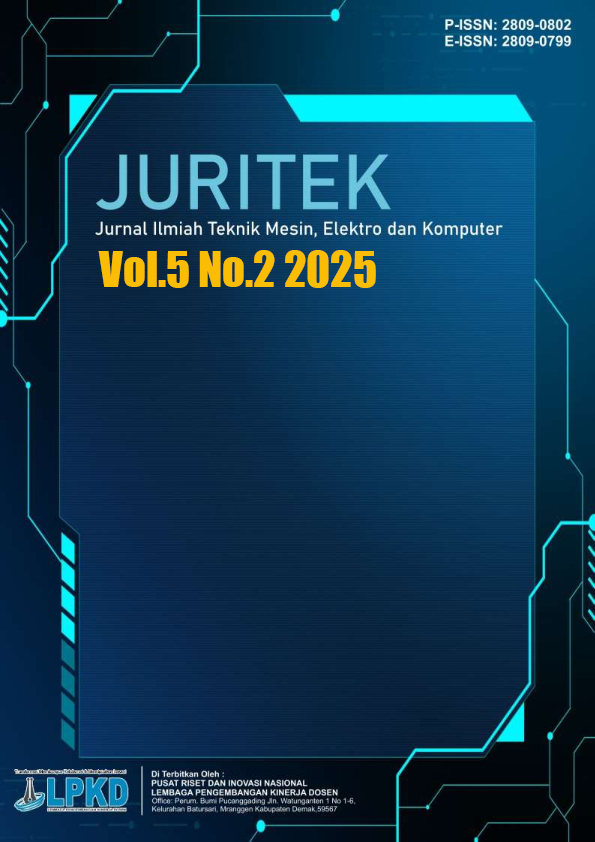Optimasi PID Kontrol BLDC Menggunakan Metode Ziegler-Nichols
DOI:
https://doi.org/10.51903/juritek.v5i2.4212Keywords:
BLDC Motor, PID Controller, Ziegler-Nichols, Speed ControlAbstract
This research focuses on optimising precise Brushless DC (BLDC) motor speed control using a Proportional-Integral-Derivative (PID) controller. The fundamental problem lies in the performance of PID control, which is highly dependent on the accuracy of determining its gain parameters (Kp, Ki, Kd), where manual tuning methods often do not provide satisfactory results. Therefore, the objective of this study is to apply the Ziegler-Nichols systematic method to the PID control tuning process for BLDC motors and then evaluate the performance of the resulting system based on key response time parameters such as rise time, settling time, overshoot, and steady-state error. The proposed method involves designing a mathematical model of the BLDC motor and applying the Ziegler-Nichols technique, specifically the Ultimate Oscillation Method, to systematically derive the values of Ku and Pu which are then used to calculate Kp (5.1), Ki (22.7), and Kd (0.29). The main findings show a dramatic performance improvement in the BLDC speed control system after the implementation of the tuned PID; the rise time is significantly reduced from 0.3728 seconds (without PID) to 0.0041 seconds, the settling time improves from 0.6642 seconds to 0.0073 seconds, and most importantly, the steady-state error of 45.38% is eliminated to 0%. The main idea synthesis is that the Ziegler-Nichols method provides an effective and practical approach to PID parameter optimization, resulting in a highly responsive, accurate and stable BLDC motor control system. In conclusion, this study successfully demonstrates that applying a PID controller with parameters determined via the Ziegler-Nichols method significantly improves the speed control quality of a BLDC motor, overcoming the steady-state error problem and substantially improving the transient response characteristics.
References
Åström, K. J., & Hägglund, T. (2006). Advanced PID control. ISA – The Instrumentation, Systems, and Automation Society.
Gamazo-Real, J. C., Vázquez-Sánchez, E., & Gómez-Gil, J. (2010). Position and speed control of brushless DC motors using sensorless techniques and application trends. Sensors, 10(7), 6901–6947. https://doi.org/10.3390/s100706901
Hameed, H. S. (2018). Brushless DC motor controller design using MATLAB applications. In 2018 1st International Scientific Conference of Engineering Sciences - 3rd Scientific Conference of Engineering Science (ISCES) (pp. 44–49). IEEE. https://doi.org/10.1109/ISCES.2018.8340526
Kommula, B. N., & Kota, V. R. (2020). Direct instantaneous torque control of Brushless DC motor using firefly algorithm based fractional order PID controller. Journal of King Saud University - Engineering Sciences, 32(2), 133.
Krishnan, R. (2010). Permanent magnet synchronous and brushless DC motor drives (1st ed.). CRC Press. https://doi.org/10.1201/9781420014235
Laily, Z. (2016). Performance comparison of PID tuning by using Ziegler-Nichols and particle swarm optimization approaches in a water control system. Journal of ICT, 15(1), 203–224.
Liu, Y., Zhu, Z. Q., & Howe, D. (2005). Direct torque control of brushless DC drives with reduced torque ripple. IEEE Transactions on Industry Applications, 41(2), 599–608. https://doi.org/10.1109/TIA.2005.844853
Lorenzini, C., Pereira, L. F. A., & Bazanella, A. S. (2018). A generalized forced oscillation method for tuning proportional resonant controllers. arXiv preprint arXiv:1807.06518. https://arxiv.org/abs/1807.06518
Mao, Q., Xu, Y., Chen, J., Chen, J., & Georgiou, T. (2023). Classical stability margins by PID control. arXiv preprint arXiv:2311.11460. https://arxiv.org/abs/2311.11460
Milani, M. M. R. A., Çavdar, T., & Aghjehkand, V. F. (2012). Particle swarm optimization—Based determination of Ziegler-Nichols parameters for PID controller of brushless DC motors. In 2012 International Symposium on Innovations in Intelligent Systems and Applications (pp. 1–5). IEEE. https://doi.org/10.1109/INISTA.2012.6246984
Miller, T. J. E. (1989). Brushless permanent-magnet and reluctance motor drives. Clarendon Press.
Mohanraj, D., et al. (2022). A review of BLDC motor: State of art, advanced control techniques, and applications. IEEE Access, 10, 54833–54869. https://doi.org/10.1109/ACCESS.2022.3175011
Ogata, K. (2010). Modern control engineering (5th ed.). Prentice Hall.
Padmaraja, Y. (2003). Brushless DC (BLDC) motor fundamentals. Microchip Technology Inc., 20(1), 3–15.
Sen, P. C. (1990). Electric motor drives and control—Past, present, and future. IEEE Transactions on Industrial Electronics, 37(6), 562–575. https://doi.org/10.1109/41.103464
Singh, B., & Singh, S. (2009). State of the art on permanent magnet brushless DC motor drives. Journal of Power Electronics, 9(1), 1–17.
Tashakori, A., Ektesabi, M., & Hosseinzadeh, N. (2011). Modeling of BLDC motor with ideal back-EMF for automotive applications. In Proceedings of the World Congress on Engineering 2011 (WCE 2011) (Vol. II). London, U.K.
Tibor, B., Fedák, V., & Durovský, F. (2011). Modeling and simulation of the BLDC motor in MATLAB GUI. In 2011 IEEE International Symposium on Industrial Electronics (pp. 1403–1407). IEEE. https://doi.org/10.1109/ISIE.2011.5984365
Ziegler, J. G., & Nichols, N. B. (1942). Optimum settings for automatic controllers. Trans. ASME, 64(8), 759–765.
Downloads
Published
How to Cite
Issue
Section
License
Copyright (c) 2025 Jurnal Ilmiah Teknik Mesin, Elektro dan Komputer

This work is licensed under a Creative Commons Attribution-ShareAlike 4.0 International License.



.png)




